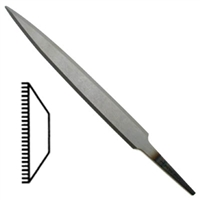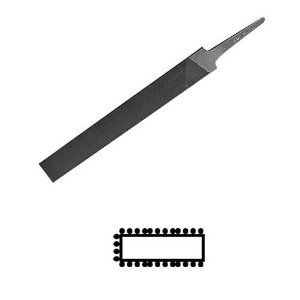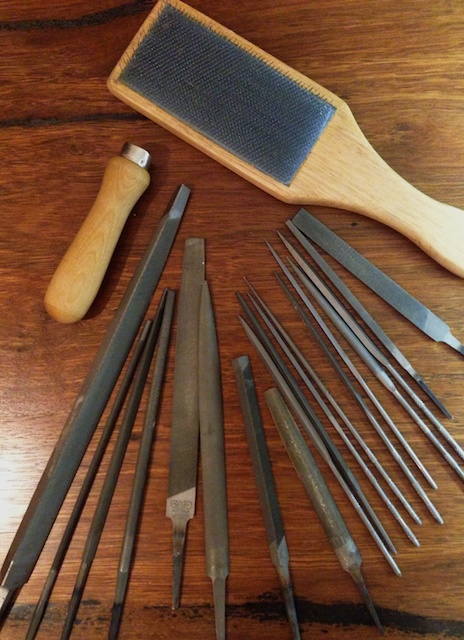There are many different cuts, shapes and varieties of files; some files are designed to meet very specific needs. When searching for the perfect files for your bench, consider the material you will be working with, the level of detail you’ll need to achieve, and the style of jewellery you’ll be making. For example, it’s not good technique to use a flat hand file to smooth the inside of a ring, nor would you get a good result attempting to take off a lot of material with a fine needle file. Choosing the right file will save you time and money.
Cuts
File cuts range from coarse, #00, to fine, #8. The lower numbered files have fewer teeth per inch and will take off more material. The higher numbered files have more teeth per inch, and take off less material, leaving a finer finish. The frustrating thing about files is that the cut number, which should represent a standardized number of teeth per inch, actually varies depending on the maker. Teeth per inch range from 30 to 295, but because the cut numbers vary from maker to maker, its impossible to give a universal definition for any particular cut. For example: a #00 file from one maker may have 30 teeth per inch, while the #00 file from another maker may have #41 teeth per inch. Fortunately, many manufacturers clarify their cut numbers with charts that you can find online.
Shapes and Sizes
File sets that include a barrette, a square, a half-round and a flat file are easy to find, but you may not need all of those shapes – or you may need them in different sizes. If you are a beginner, you may only need a half-round, flat hand file, plus a few needle files in other shapes.
Hand files are about 4-10 inches long, and can be used on a wide variety of jewellery making materials. Needle files are often 4-8 inches long and are best used for refining detail. Hand and needle files both come in the same shapes, but often needle files will be made only in finer cuts
Some common files are listed below:
BARRETTE – This popular file has teeth on one flat side. The back side of the file is smooth and tapered to decrease the chance that you will mar another part of the jewellery as you file. Our Suggestion: #4 or #6 needle file
FLAT (also called Hand Files) files are just that, Flat. The flat surfaces are used to file large flat areas, straight edges, outside curves, etc. This file can leave a very clean, level edge on your material. In needle files, the shape of a flat file has made variations, including warding, equalling, round-edged pillar, and crochet files. Our Suggestion: #2 cut hand file
HALF-ROUND – a half round file has one flat side and one rounded side. The rounded side is used for inside curves such as the inner part of a ring shank.
Cleaning
Cleaning your files keeps them in better condition for a longer time. Tap the file to knock the big debris out of the teeth after using it. Then use a file card to clean out the remaining debris by running the card across the file at the same angle as the teeth. For very stubborn spots use a small sheet of solder and flick out the metal in the direction of the teeth. You should always clean your files when you switch material, and especially after using copper. And NEVER use your jewellery files on any ferrous (containing iron) metals. This will cause contamination and create all types of problems later on.
Technique
The purpose of filing is to remove excess metal. Proper filing can eliminate a lot of work in the later stages and can also extend the life of your files dramatically. Files are designed to cut on the forward movement. Downward pressure is exerted on the forward stroke to give the teeth maximum cut into the metal. Do not file on the back stroke. (No see-saw like filing!!!) Lift the file slightly on the back stroke to avoid unnecessary wear on the file.
Use the largest file you can for the job, depending on the surface. Using small files on large surfaces leaves grooves across the piece. Use a #2 cut file for removing large amounts of metal and a #4 cut for fine trimming and shaping.
For flat surfaces, use the flat file or the flat surface of the half-round file. Lay the file against the closest edge of the piece, bracing the piece on your bench pin and push down, forward, and across the edge. Maximum pressure is not necessary, but you do need to press down into the metal.
For a curved surface (like the outside of a ring shank), use the flat side, brace the ring on your bench pin and push down and forward, at the same time rolling the file around the shape of the ring to ensure even filing with no flat spots.
For inside curves, use the rounded side of your half-round file in a forward and downward motion, rolling the file away from you as you go across the piece.
Large files are most effectively used with handles. Installing a handle on each file prevents the possibility of injuring the hand or wrist with the tang and allows full use of the cutting surface.
With practice, you will develop your own style of filing. PRACTICE (and lots of it) MAKES PERFECT!
Files are a big investment, but an integral part of any jewellers bench, so be sure to buy the ones that meet your needs.
Workingsilver sells quality Swiss made 6″ files in a variety of shapes and cuts, as well as Needle File sets in 4 cut for finer work. You can find all our files HERE.






